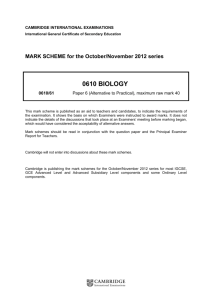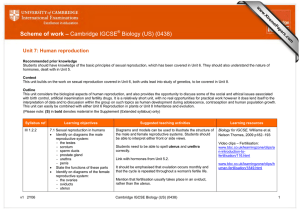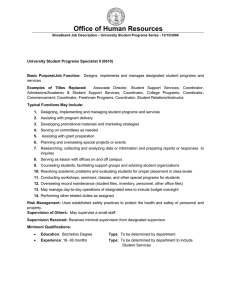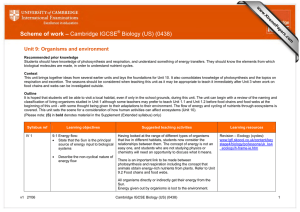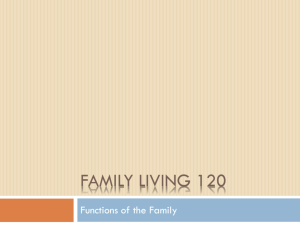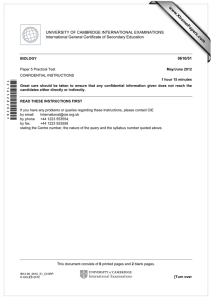0610/01
advertisement
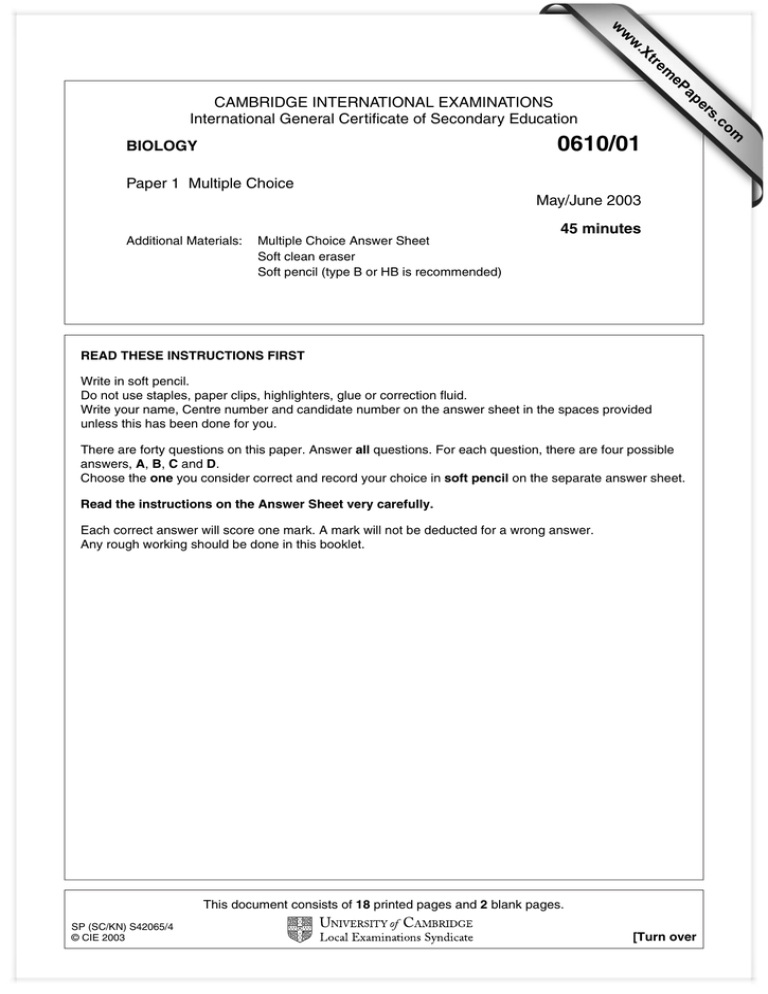
w w ap eP m e tr .X w 0610/01 BIOLOGY Paper 1 Multiple Choice May/June 2003 45 minutes Additional Materials: Multiple Choice Answer Sheet Soft clean eraser Soft pencil (type B or HB is recommended) READ THESE INSTRUCTIONS FIRST Write in soft pencil. Do not use staples, paper clips, highlighters, glue or correction fluid. Write your name, Centre number and candidate number on the answer sheet in the spaces provided unless this has been done for you. There are forty questions on this paper. Answer all questions. For each question, there are four possible answers, A, B, C and D. Choose the one you consider correct and record your choice in soft pencil on the separate answer sheet. Read the instructions on the Answer Sheet very carefully. Each correct answer will score one mark. A mark will not be deducted for a wrong answer. Any rough working should be done in this booklet. This document consists of 18 printed pages and 2 blank pages. SP (SC/KN) S42065/4 © CIE 2003 [Turn over om .c s er CAMBRIDGE INTERNATIONAL EXAMINATIONS International General Certificate of Secondary Education 2 1 2 Which of the following lists contains only arthropods? A annelids, insects, myriapods B arachnids, crustaceans, myriapods C crustaceans, insects, molluscs D insects, myriapods, nematodes The diagram shows a half-flower. petal stamen ovary Use the following key to identify the type of flower. 1 petals attached above the ovary ……………….. petals attached below the ovary ……………….. go to 2 go to 3 2 stamens less than ten …………………………… stamens more than ten …………………………. type A type B 3 sepals absent …………………………………….. sepals present ……………………………………. type C type D 0610/01/M/J/03 3 3 The diagram shows some external features of a rat. Which features, seen in the diagram, show that a rat is a mammal? 4 A diaphragm and lungs B fur and whiskers C legs and tail D milk and sweat production The table shows features that may be found in living cells. Which features are found in a liver cell? 5 large central vacuole chloroplasts cellulose cell wall A ✓ ✓ ✓ B ✓ ✓ ✗ C ✗ ✗ ✓ D ✗ ✗ ✗ The diagram shows a section through a mesophyll cell of a leaf. Which part is partially permeable? A B C D 0610/01/M/J/03 [Turn over 4 6 The diagram shows four cells. 1 2 3 4 Which cells transport water? 7 A 1 and 2 B 1 and 3 C 2 and 4 D 3 and 4 In the pancreas, there are groups of cells that make insulin. What describes these cells? 8 A an organ in an organism B an organ system in an organism C cells within a cell wall D tissue in an organ In an osmosis experiment, four potato strips, each 5 cm in length, were left in salt solutions of different concentrations. The table shows the lengths of the strips after 30 minutes. Which salt solution was the most concentrated? salt solution length of strips after 30 minutes A 4.5 cm B 4.8 cm C 5.0 cm D 5.3 cm 0610/01/M/J/03 5 9 The diagram shows a section through a leaf. Y X By which process does carbon dioxide pass from X to Y? A diffusion B osmosis C translocation D transpiration 0610/01/M/J/03 [Turn over 6 10 The graph shows how the rate of an enzyme-controlled reaction changes with pH. rate of enzyme-controlled reaction 1 2 3 4 pH Which statement is correct? A This enzyme is destroyed by acidic conditions. B This enzyme works best in acidic conditions. C This enzyme works best in alkaline conditions. D This enzyme works best in neutral conditions. 11 Which kind of molecule could be an enzyme? A fat B glucose C protein D starch 0610/01/M/J/03 5 6 7 7 12 The table shows the mass of some nutrients found in 100 g of four different foods. carbohydrate /g fat /g protein /g vit C / mg vit D / mg beans 10.0 0.4 5.0 3.0 0.0 bread 48.0 1.5 9.0 0.0 0.0 cheese 0.0 34.0 25.0 0.0 0.4 eggs 0.0 11.0 13.0 0.0 1.5 food Which foods would best prevent rickets and scurvy? rickets scurvy A beans bread B bread cheese C cheese eggs D eggs beans 13 The diagram shows some food moving along the alimentary canal. direction of movement of food circular muscle contracting food moved along What is the name of the process that pushes the food along? A absorption B digestion C peristalsis D swallowing 0610/01/M/J/03 [Turn over 8 Use this diagram, which shows a cross-section through a leaf, to answer questions 14 and 15. A B C D 14 Which cell type absorbs the most carbon dioxide during the day? 15 A leafy shoot is placed in a solution of red dye. After 30 minutes, which part of a leaf from this shoot will contain the red dye? 16 The diagram shows cross-sections of three types of blood vessel (not drawn to the same scale). X Y What is the identity of the three vessels? artery capillary vein A X Y Z B Y X Z C X Z Y D Y Z X 0610/01/M/J/03 Z 9 17 What is happening in a bolus of food as it passes along the oesophagus? A Fats are being digested. B Fats are being emulsified. C Protein is being digested. D Starch is being digested. 18 The photograph shows some blood as seen under the microscope. X What is the function of the cell labelled X? A blood clotting B carrying oxygen C defending against disease D transporting hormones 0610/01/M/J/03 [Turn over 10 19 The roots of green plants take up nitrates from the soil. What are the nitrates used to make? A fat B glucose C protein D starch 20 Which substance in cigarette smoke causes lung cancer? A carbon dioxide B carbon monoxide C nicotine D tar 21 Why does anaerobic respiration by yeast release less energy than aerobic respiration? A Energy is lost in carbon dioxide. B Energy is lost in oxygen. C Energy remains trapped in ethanol. D Energy remains trapped in lactic acid. 22 In which organ are excess amino acids broken down? A bladder B brain C kidneys D liver 0610/01/M/J/03 11 23 The diagram shows a section through part of the human eye. Which part contains muscles? A B C D 24 The diagram shows a germinated bean seed with a horizontal radicle. This is placed on a slowly rotating disc and is left for three days. electric motor slowly rotating disc radicle bean seed Which diagram shows the appearance of the radicle after three days? A B C 0610/01/M/J/03 D [Turn over 12 25 The diagram shows the male reproductive system. Where is testosterone produced? B C D A 26 The diagram shows stages in the life of a human from zygote to fetus. Which processes occur during these stages? fertilisation growth development A ✓ ✗ ✓ B ✓ ✗ ✗ C ✗ ✓ ✗ D ✗ ✓ ✓ 0610/01/M/J/03 13 27 The diagram shows stages of a menstrual cycle. During which stage is a woman most fertile? kdown of breaus lining uter A –m en str u at ion n ke ing of ute ru s l i n in g sl ru B th ic ovulatio n uterine repa ir g inin D thicke n e d ut e C 28 The diagram shows a germinating bean seed with the seed coat removed. X Y Z What are the structures X, Y and Z? structure X Y Z A cotyledon radicle plumule B plumule cotyledon radicle C plumule radicle cotyledon D radicle plumule cotyledon 0610/01/M/J/03 [Turn over 14 29 Which are needed for seed germination? A carbon dioxide and oxygen B chlorophyll and light C soil particles and mineral salts D water and a suitable temperature 30 The nucleus in each cell in the stem of a plant contains 32 chromosomes. How many chromosomes are there in the nuclei of its pollen grains? A 8 B 16 C 32 D 64 31 A heterozygous, brown-eyed woman and a blue-eyed man have a child. If the allele for brown eyes is dominant to the allele for blue eyes, what are the chances that the child is blue-eyed? A 1 in 2 B 1 in 3 C 1 in 4 D none 32 A female fruit fly with short wings mates with a male with long wings. All the offspring are longwinged. Two of these offspring mate with each other. What percentage of their offspring will have long wings? A 25 % B 50 % C 75 % 0610/01/M/J/03 D 100 % 15 33 The diagram shows a simple food chain. 1 2 green plants chickens 3 wild dogs Which process releases the energy which is then lost at 1, 2 and 3? A evaporation B photosynthesis C respiration D translocation 34 The diagram shows another simple food chain. Which is the primary (first) consumer? A B C D solar energy grass caterpillar bird 35 The diagram shows part of the water cycle. Which arrow represents condensation? clouds C D B water vapour plants soil A river 0610/01/M/J/03 [Turn over 16 36 The diagram shows the release of a gas into the atmosphere from different sources. Sun soil urine sheep tree What is this gas? A carbon dioxide B nitrogen C oxygen D water vapour 37 The diagram shows part of a food web. snakes badgers frogs hedgehogs worms slugs plants What is most likely to increase the size of the frog population? A fewer hedgehogs B fewer worms C more badgers D more snakes 0610/01/M/J/03 17 38 The diagram shows how some land near a lake is used. rain forest land for grazing cattle land for growing crops lake silt Which of the following is most likely to cause the lake to flood? A cutting down the forest B removing the cattle C taking the silt out of the lake D using pesticides on the crops 39 The diagram shows part of a food chain in a lake. single-celled photosynthetic organism small crustacean carnivorous bird frog The chart shows the concentration of a pesticide in the bodies of each organism in the chain. Which organism on the chart is the frog? concentration of pesticide A B C D organism 0610/01/M/J/03 [Turn over 18 40 The diagram shows an area being developed for industry and agriculture. fertilisers, herbicides and pesticides applied to the land smoke containing sulphur dioxide factory trees being cut down to provide agricultural land lake Which would be the most likely to cause an initial increase in plant life in the lake? A fertilisers B herbicides C pesticides D smoke 0610/01/M/J/03 19 BLANK PAGE 0610/01/M/J/03 20 BLANK PAGE 0610/01/M/J/03
